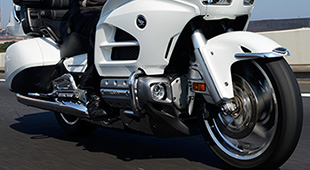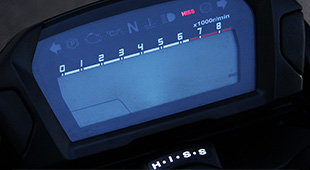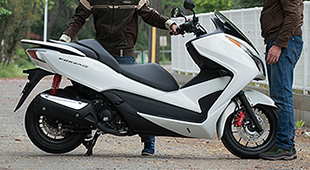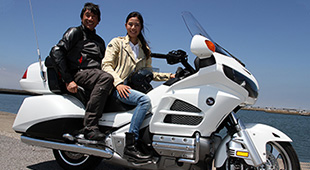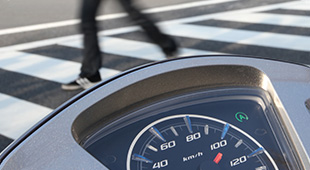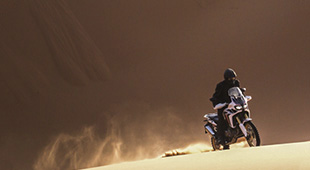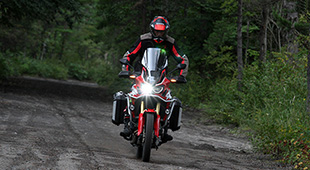Tech Views — Vol.8 CRF1000L Africa Twin
Development Story (2/5)
Slim and Lightweight,
Yet a Big Off-Roader With a Feeling of Volume
The first step in the development of the new model began with deciding on a rough silhouette. What sort of bike should be aimed for? What was its concept? The team discussed a wide range of important factors and their reasons for including them, and gradually these ideas came together to form a rough image.
Yamakura — "In its first stages of development, our new Africa Twin was good in terms of concept, which was that of a large-displacement off-road bike that could be easily ridden over dirt and mountain trails, while also being a big touring bike that could provide a comfortable ride over long distances. I wanted to focus all the new technologies we'd accumulated over the past 25 years on that concept in the creation of this new version of the Africa Twin.
"Since I myself was an owner of an original Africa Twin, I considered all the things I wanted to carry over and refine, as well as new features that I thought should be incorporated into the new model. Also, from an owner's perspective, I thought it would be good if the new model could be 'more like this, or that' and of course those factors were also included in the development. We purchased another secondhand Africa Twin for development purposes, and every member of the team rode it extensively in order to raise our common consciousness."
In the meantime, an interesting phenomenon was also taking place. One after another, team members were buying their own Africa Twins, and soon a remarkable total of seven of the bikes were gathered in this one group.
"I bought an Africa Twin on Yamakura's suggestion. One reason was that since I was assigned to the job of designing the new Africa Twin, I thought I should first be armed with some first-hand knowledge about the merits of the old one. I figured that if I could more precisely understand the Africa Twin's various features, I could better reflect them in the new machine's development."
This is Akihiro Komatsu, who was in charge of design at Honda's Motorcycle R&D Center. Komatsu is 12 years older than Yamakura and Iida, and a brilliant, highly logical person. Smiling behind black-rimmed glasses, his sharp, experienced eyes seem able to see through everything. Put in charge of the Africa Twin's overall design, Komatsu first set out to gather ideas from other designers about a new Africa Twin.
Komatsu — "I engaged designers in Japan, the United States and Europe in a sort of design competition, and asked each of them to sketch out their own ideas of how a new Africa Twin should look. What sort of direction should it take, what styling, what sense of volume? A lot of original ideas arose from this small group of designers. Still, what was particularly interesting was that nearly all were agreed on creating a large-displacement off-road model that's lightweight and slim, yet still has a robust sense of volume. Going on that, the bike's styling gradually began to take shape."
Komatsu could sense the passion that both Yamakura and Iida radiated when talking about their dreams for the Africa Twin. As the development project gradually advanced from its initial stages, and the machine's actual form slowly began to take shape, the younger engineers occasionally revealed their seemingly fantastic dreams.

Komatsu — "I thought it important not to disturb those dreams. Often, the ideals of the chassis and engine engineering departments conflict with those of the design department, so naturally I thought that this time the opinions of the designers should be restrained as much as possible to help the engineers' dreams come true. I could feel that the Africa Twin was their dream, and that it was a bike that needed to be created from a strong sense of passion."
As it turns out, Iida had the same idea.
Iida — "Yamakura's enthusiasm and dreams for the new Africa Twin came to inspire more and more people around him. My feeling was that, as an engine designer, I couldn't be selfish. First, Yamakura and the other engineers had their strong impressions of how the new Africa Twin should look, and any opinions about desired features presented themselves thereafter in a sort of common consciousness. As a result, my feeling was that we should design an engine that was best suited to the completed motorcycle."
Normally, engineers make a point of giving an engine they're designing a certain amount of flexibility, so that it can be used in possible future applications. When it comes to big dual sport models, there are often times when currently existing engines are considered for use, or an engine's basic design and construction are appropriated for use in an on-road model at a later date. However, the team adamantly refused to reflect this thinking in the Africa Twin's engine development. This engine must be designed solely for the new Africa Twin — otherwise their enthusiastic dreams might evaporate into thin air.

Iida — "As development continued, we reached the stage where Komatsu's design was nearing completion and the space for the engine could roughly be seen. Once the motorcycle's basic silhouette became visible, we could focus on creating an engine design based on a relatively fixed set of specifications. In this way the development plans began to take shape. Of course, at this point in time, we didn't really care whether the engine was air-cooled or liquid-cooled, or had a single, twin or V4 configuration. Also, owing to the Africa Twin's history and known qualities, we took a good look at the original V-twin configuration, but finally decided it best not to cling to the past in our engine selection."
The original Africa Twin had long been synonymous with Honda's most prominent large-displacement off-road models. Fundamentally, its size, volume and integrated cowling reminded people of the Paris-Dakar racing machines, which were also equipped with V-twin engines. However, in considering what was required of the new Africa Twin, attention paid to the optimal size, shape, weight and necessary specifications of the complete package helped the team find the best engine for the job, which turned out to be a parallel-twin engine rather than a variation on the original V-twin.
- Top
- History
- A New Era
- Technical Points
- Development Story

